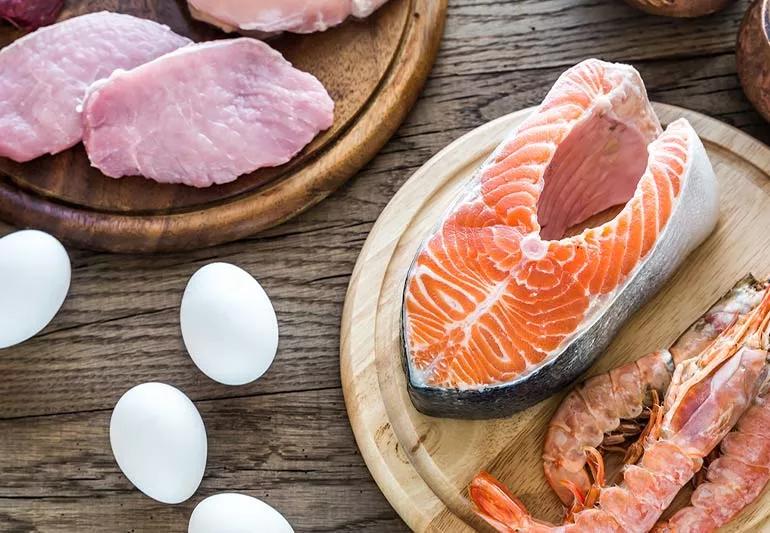This restrictive, rules-heavy diet can lead to micronutrient deficiencies, among other issues

When you’re trying to lose weight, you’re also hoping for something long term: You don’t want to gain it all back down the road. Sustainability is key — so it’s understandable that an eating style like the Dukan diet might sound appealing.
Advertisement
Cleveland Clinic is a non-profit academic medical center. Advertising on our site helps support our mission. We do not endorse non-Cleveland Clinic products or services. Policy
“Lose the weight and keep it off forever” is the promise of French nutritionist Pierre Dukan’s namesake diet, which he created in 2000. It’s a four-step diet plan that claims to work in perpetuity — which is to say, well, forever.
But is the diet too good to be true? Slow down before jumping in. Registered dietitian Kendra Weekley, RD, cautions that the Dukan diet is too restrictive, and you may miss out on key nutrients while you’re following it.
The Dukan diet is based on the premise that 95% of people who diet eventually return to their pre-diet ways of eating and gain back the weight they lost. It says it can “redesign your eating habits and help you permanently stabilize your weight” in four phases (steps).
“Essentially, this is an elimination diet,” Weekley notes. “Any diet that eliminates a number of nutrition-dense and calorie-dense foods will facilitate rapid weight loss.”
The Dukan diet is made up of four phases, all varying in length and rules that can last up to 12 months.
The first two phases are the weight loss phases; the third phase is about developing behavior changes to prevent the weight from coming back; and the fourth phase and final phase is a maintenance phase, designed to last for life.
Advertisement
“During each of these phases, you choose from a very limited list of foods that you can eat an ‘unlimited’ amount of,” Weekley says. “Many of these foods are also digested slowly so that you will feel fuller longer, which can then lead to a decrease in calorie intake and promote weight loss.”
Here’s a look at what each phase entails.
The first phase of the Dukan diet is also known as the “pure protein phase.”
The goal of the Attack phase is to reach ketosis, a metabolic state that happens when your body starts burning fat for energy. Ketosis typically happens when you’re on a high-fat diet with moderate protein intake and little to no carbohydrates. When your body doesn’t have carbs to break down for energy, it starts breaking down fat instead, which can lead to quick weight loss.
“Your body needs energy to function, and it typically uses glucose from carbohydrates to create that energy,” Weekley explains. “When there’s no glucose available, though, the body can make energy from fat. Breaking down fat creates a compound called ketones, which are then converted to energy.”
While trying to reach ketosis, you could experience short-term side effects like nausea, vomiting, increased fatigue and loose stool. But they should self-resolve as your body gets used to the diet — usually a few days or a couple of weeks.
Tired of meat yet? During the second phase of the Dukan diet, you start to reintroduce some vegetables into your diet. But it’s not quite that simple.
Once you’ve reached your weight-loss goal, you’ll head into phase three, which is the beginning of your efforts to maintain that loss. Here, the rules get even more complicated.
Advertisement
“The Consolidation phase gives you guidelines on new foods that you can add in each week,” Weekley says. “It also has rules on certain days that act as accountability to maintain what it calls your ‘true weight.’”
Here’s what you can expect in this third phase:
The fourth and final phase of the Dukan diet says it will help you reach “permanent stabilization” of your weight loss. No foods are off limits anymore, but there are three non-negotiable rules:
This phase is meant to last, well, forever. No pressure.
Advertisement
Hydration is always important, but especially when you’re not getting much fiber. On the Dukan diet, you’re encouraged to drink at least six to eight glasses of water per day, with the recommendation that you aim for 2 liters — and maybe more, on very hot days or days when you exercise a lot.
Weekley says that she doesn’t see a lot of positives to following the Dukan diet, and there’s surprisingly little data available on it. Its focus on whole foods, including lean proteins, is a good thing, she says — but you’re better off achieving that same focus through a less restrictive, more sustainable style of eating.
She explains two benefits of the Dukan diet and how you can tap into these benefits without following such a complicated and restrictive diet.
Lean proteins are a major element of the Dukan diet. “There can be some positives to a diet that shifts to lean proteins, as they can contribute to heart health and blood sugar control and can have anti-inflammatory properties,” Weekley says.
Good sources of lean protein include:
But there’s no need to go all-or-nothing. For successful, sustainable weight loss, aim for the healthy plate method: Your plate should be filled with 50% vegetables, 25% carbohydrate or starch and 25% lean protein.
Advertisement
The Dukan diet focuses on whole, one-ingredient foods that you prepare yourself, which means you don’t have to meticulously parse out your portions or count calories.
“Measuring and counting calories can turn into disordered eating patterns, and eliminating that from a diet can be less stressful for some people,” Weekley notes.
A dietitian can help you figure out how many calories you need in a day and what a healthy diet looks like for you, whether or not you’re counting caloric intake.
When looking at the pros and cons of the Dukan diet, the cons win out. This diet is problematic for a few reasons, Weekley says.
“The rules of the diet are complicated and can be difficult to follow,” she reiterates. “There’s not a lot of scientific data supporting the rules of the diet.”
Here are some of the key issues with the Dukan diet.
Simply put, this diet has a lot of rules. “There are too many of them, and they’re hard to keep track of,” Weekley says. “The more rules and regulations a diet has, the more room there is for error and poor compliance.”
This is one of the key reasons that so many fad diets don’t work. When there are too many restrictions, you’re more likely to get bored and frustrated, which can lead you right back into the arms of your old eating patterns.
It’s not just about the number of rules; it’s also about how hard those rules are to follow. And in this case, many of the Dukan diet’s rules aren’t particularly practical for most people’s everyday lives.
The alternating day rule (one high-protein day and followed by one “cruise” day), for example, can be hard to keep track of and plan for.
“It can be incredibly challenging to prepare meals for your family when you have to constantly keep track of what day of your diet you’re on,” Weekley points out. “And that phase can go on for months!”
When you start the Dukan diet, you may feel tired and fatigued from a lack of macronutrients (like carbohydrates) and from consuming so many fewer calories than you’re used to.
When you get to the Cruise phase, more serious concerns come into play. With such a limited vegetable list — plus no fruit or whole grains — you’re at risk for vitamin and nutrient deficiencies.
“There’s a real possibility that with such limited numbers of foods, you may miss out on critical micronutrients and experience macronutrient imbalances,” Weekley warns. “Some participants might not get to eat fruit or certain vegetables for several months.”
One study found that women who followed the Dukan diet had low levels of vitamin C.
The Dukan diet plays into people’s fears about not being able to maintain weight loss by advertising that it will help you achieve lifelong weight management. But Weekley says you’re likely to regain some or all of the weight you lose while following this diet.
Losing weight very quickly lowers your body’s basal metabolic rate (BMR) — the minimum calories your body needs to function while at rest. This makes it harder for you to burn calories, which then makes it more difficult for you to continue to lose weight or to maintain weight loss.
“Your body has a ‘weight set point’ that it likes to settle at,” Weekley says. “The Dukan diet calls this your ‘true weight’ and tries to get you to reach it in a short period of time — but such drastic weight loss can shift your BMR, which makes it more difficult to maintain your lower weight.”
Here’s one more unpleasant side effect to add to the mix: Your daily dose of oat bran probably isn’t enough to keep you … err, regular.
“With so much protein and very little soluble fiber (other than a few teaspoons of oat bran), some people might struggle with abnormal bowel patterns, especially constipation,” Weekley says.
If you have diabetes or otherwise struggle with blood sugar management, skip the Dukan diet, as it could be unsafe for you.
“Because carbohydrates aren’t allowed for days, followed by very restricted carbohydrates for weeks and months, this diet may be dangerous for people who often have low blood sugars or who are not able to maintain their own blood sugars for an extended period of time,” Weekley warns.
What if you don’t have blood sugar issues? The Dukan diet may not necessarily be unsafe, but that doesn’t mean you should try it.
“There’s not a lot of data on the long-term effects of high-protein diets,” Weekley states. “For people who don’t have chronic disease, this diet may be safe for a short period of time, but I still wouldn’t recommend it in the long term.”
Restrictive, complicated fad diets are rarely (if ever) the answer to your weight woes — and they certainly don’t teach healthy, sustainable eating habits.
Adopting a low-carbohydrate, high-protein eating style can be a safe and effective way to lose weight, shifting your macronutrient intake in a way that encourages weight loss but doesn’t deprive your body of what it needs.
“Low-carb, high-protein diets don’t eliminate entire food groups (like fruits and grains) but instead include them in much smaller quantities,” Weekley says. “This helps avoid micronutrient deficiencies and also makes it easier for you to stick with it.”
The best way to pursue a healthy diet is to work with a registered dietitian who’ll help you come up with a tailored, individualized strategy — not a one-size-fits-all fad diet full of hard-to-follow rules and restrictions.
“Some people need structure and want someone to tell them what to eat, while others benefit from brainstorming sessions of healthy plate ideas for themselves and their families,” Weekley says. “A balanced diet is the way to go, and a dietitian can help you make the right food choices for your nutrition goals.”
Learn more about our editorial process.
Advertisement

Extreme calorie restriction isn’t the way to long-term weight loss

The demanding plan eliminates dairy, grains and other common foods from your plate for 30 days

Learn how to properly identify what’s edible — and inedible — in the wild

Common culprits and pinpointing the cause of your food issues

The good and bad of this low-carb diet

We break down the Atkins, ketogenic, GOLO, Military and Taco diets

Extreme raw diets are tough to follow and can be risky

The science isn’t very promising

Type 2 diabetes isn’t inevitable with these dietary changes

Applying a hot or cold compress can help with pain